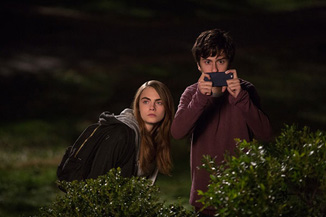|
|
Movie Review: Paper TownsBy Ben GruchowJuly 29, 2015
Walt Whitman and Woody Guthrie are sewn into developments and asides, but they’re never used to influence thought or action on the part of the characters; the script is just name-dropping and mistaking it for texture and color. Articulation in speech can convey hidden layers of personality and meaning, or it can be deployed effectively as an illustration of a defense mechanism; here, it just comes across as the mark of a writer desperately trying to show that he’s hip to the kids these days, with the touch-screens and the Facebook and the Wikipedia (manifested here, in the movie’s worst display of winking at itself, as an identical site called Omnictionary.) Quentin is the least-interesting character on screen; his evident purpose in life begins and ends with obsessing about Margo’s whereabouts and nature. The people surrounding him are more fortunate: Halston Sage, as Margo’s best friend Lacey, brings a confusion and realism to her scenes that she doesn’t try to oversell. She’s the only one affected by Margo’s departure who actually seems to react like a person. Meanwhile, Justice Smith is downright natural and likable as Quentin’s friend Radar; he has a nice grasp of timing and feeling that serves him well during scenes with his girlfriend, played with equal unforced naturalism by Jaz Sinclair, and during late scenes with Quentin, Lacey, and their friend Ben, played by Austin Abrams (this actor pulls a fast one on a thin character, and emerges with something like sympathy and an arc). Nat Wolff’s Quentin has far more chemistry with any of these individuals than he does with Cara Delevingne’s Margo, and the degree to which the movie works depends on how far away the main characters are kept.
|

|
|
|

|
Thursday, October 31, 2024
© 2024 Box Office Prophets, a division of One Of Us, Inc.


